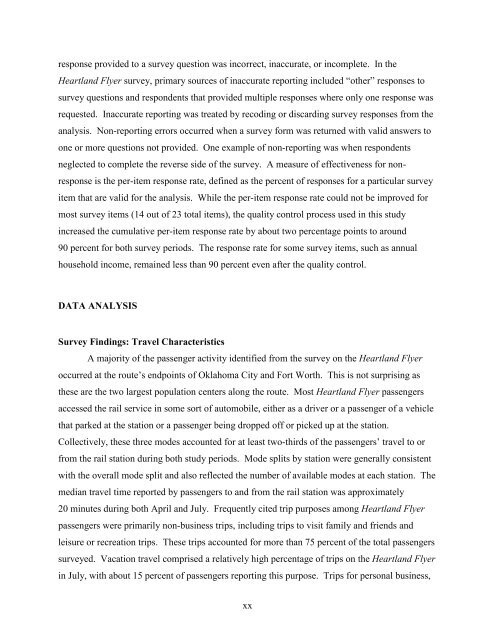Measuring the Benefits of Intercity Passenger Rail: A Study
Measuring the Benefits of Intercity Passenger Rail: A Study
Measuring the Benefits of Intercity Passenger Rail: A Study
You also want an ePaper? Increase the reach of your titles
YUMPU automatically turns print PDFs into web optimized ePapers that Google loves.
esponse provided to a survey question was incorrect, inaccurate, or incomplete. In <strong>the</strong><br />
Heartland Flyer survey, primary sources <strong>of</strong> inaccurate reporting included “o<strong>the</strong>r” responses to<br />
survey questions and respondents that provided multiple responses where only one response was<br />
requested. Inaccurate reporting was treated by recoding or discarding survey responses from <strong>the</strong><br />
analysis. Non-reporting errors occurred when a survey form was returned with valid answers to<br />
one or more questions not provided. One example <strong>of</strong> non-reporting was when respondents<br />
neglected to complete <strong>the</strong> reverse side <strong>of</strong> <strong>the</strong> survey. A measure <strong>of</strong> effectiveness for nonresponse<br />
is <strong>the</strong> per-item response rate, defined as <strong>the</strong> percent <strong>of</strong> responses for a particular survey<br />
item that are valid for <strong>the</strong> analysis. While <strong>the</strong> per-item response rate could not be improved for<br />
most survey items (14 out <strong>of</strong> 23 total items), <strong>the</strong> quality control process used in this study<br />
increased <strong>the</strong> cumulative per-item response rate by about two percentage points to around<br />
90 percent for both survey periods. The response rate for some survey items, such as annual<br />
household income, remained less than 90 percent even after <strong>the</strong> quality control.<br />
DATA ANALYSIS<br />
Survey Findings: Travel Characteristics<br />
A majority <strong>of</strong> <strong>the</strong> passenger activity identified from <strong>the</strong> survey on <strong>the</strong> Heartland Flyer<br />
occurred at <strong>the</strong> route’s endpoints <strong>of</strong> Oklahoma City and Fort Worth. This is not surprising as<br />
<strong>the</strong>se are <strong>the</strong> two largest population centers along <strong>the</strong> route. Most Heartland Flyer passengers<br />
accessed <strong>the</strong> rail service in some sort <strong>of</strong> automobile, ei<strong>the</strong>r as a driver or a passenger <strong>of</strong> a vehicle<br />
that parked at <strong>the</strong> station or a passenger being dropped <strong>of</strong>f or picked up at <strong>the</strong> station.<br />
Collectively, <strong>the</strong>se three modes accounted for at least two-thirds <strong>of</strong> <strong>the</strong> passengers’ travel to or<br />
from <strong>the</strong> rail station during both study periods. Mode splits by station were generally consistent<br />
with <strong>the</strong> overall mode split and also reflected <strong>the</strong> number <strong>of</strong> available modes at each station. The<br />
median travel time reported by passengers to and from <strong>the</strong> rail station was approximately<br />
20 minutes during both April and July. Frequently cited trip purposes among Heartland Flyer<br />
passengers were primarily non-business trips, including trips to visit family and friends and<br />
leisure or recreation trips. These trips accounted for more than 75 percent <strong>of</strong> <strong>the</strong> total passengers<br />
surveyed. Vacation travel comprised a relatively high percentage <strong>of</strong> trips on <strong>the</strong> Heartland Flyer<br />
in July, with about 15 percent <strong>of</strong> passengers reporting this purpose. Trips for personal business,<br />
xx
















